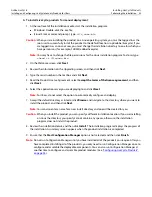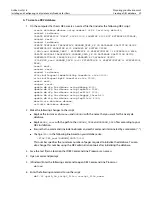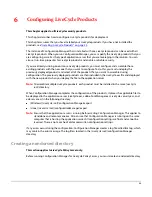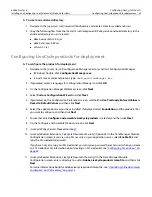
Adobe LiveCycle
Configuring LiveCycle Products
Installing and Configuring LiveCycle Security Products for JBoss
Configuring LiveCycle products for deployment 46
12. (LiveCycle Reader Extensions, LiveCycle Document Security) On the Data Manager Module
Configuration continued screen, accept the default values for the following properties or enter new
values, and then click
Next
:
●
Local storage sweep interval (in seconds):
The amount of time between attempts to delete any
files that are no longer needed and were used to pass the document data between LiveCycle
services running on the same computer.
●
Global storage sweep interval (in seconds):
The amount of time between attempts to delete any
obsolete files that were used to pass the document data between LiveCycle services running on
different computers. Specify this property only when deploying LiveCycle products in a clustered
environment.
●
Default maximum inline size (in bytes):
The maximum number of bytes kept in memory when
passing documents between different LiveCycle components. Documents that exceed this
maximum are stored on the hard drive. Use this property for performance tuning. (See
“Optimizing
inline documents and impacts on JVM memory” on page 73
.)
●
Default disposal time-out (in seconds):
The maximum amount of time during which a document
being passed between different LiveCycle components is considered active. After this time has
passed, any files used to store this document are subject to removal. Use this property to control the
usage of disk space.
●
Use NFS protocol (Windows only):
Select this option when deploying LiveCycle products in a
clustered environment. Additional NFS software should be installed on your computer running
Windows before enabling this option. This option does not affect deployments on Linux.
●
Global storage directory:
A path to a shared directory used to store long-lived documents that are
passed between LiveCycle products. Using an NFS shared directory can help to improve
performance. (See
“Optimizing inline documents and impacts on JVM memory” on page 73
.)
13. (LiveCycle Reader Extensions, LiveCycle Document Security) (Optional) On the Font Manager Module
Configuration screen, select the fonts for the product to use in addition to the fonts that are included
with the product. In the
Fonts directory
box, type the path or browse to the directory that contains
the fonts to add, and then click
Next
.
Note:
Your right to use fonts provided by parties other than Adobe is governed by the license
agreements provided to you by such parties in connection with those fonts, and is not covered
under your license to use Adobe software. Adobe recommends that you review and ensure you
are in compliance with all applicable non-Adobe license agreements before using non-Adobe
fonts with Adobe software, particularly with respect to use of fonts in a server environment.
14. (LiveCycle Reader Extensions, LiveCycle Document Security) On the Trust Directory Selection screen,
select one of the following options:
●
If you do not have a trust directory, select
Create a new trust directory
and click
Next
. Proceed to
step
15
.
●
To use an existing trust directory, select
Use existing trust directory
, click
Browse
to navigate to
and select the directory, and then click
Next
and proceed to step
20
. A valid existing trust directory
must contain the following files and directories:
●
/trust.xml
●
/credentials/
●
/certificates/
●
/CRLs/
●
/keystore
●
/trust.sig






























